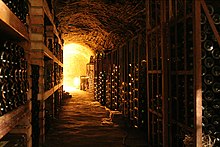Wine cellar
Purpose:
– Wine cellars protect alcoholic beverages from harmful external influences
– Provide darkness, constant temperature, and humidity
– Proper storage maintains wine quality and can improve aroma, flavor, and complexity
– Different types of wine have varying sensitivity to temperature variances
– Higher alcohol and sugar content in wine makes it less sensitive to temperature changes
Conditions:
– Wine can be stored between 7–18°C (45–64°F) with gradual variations
– Ideal temperature for short-term storage and aging is 13°C (55°F)
– Wine matures differently and more slowly at lower temperatures
– Significant temperature swings above 14 degrees can speed up the aging process
– Wines age normally between 10–14°C (50–57°F)
Active versus passive:
– Wine cellars can be active or passive cooled
– Active cellars require specialized cooling systems
– Passive cellars need to be in naturally cool and damp areas
– Passive cellars are less predictable but cost nothing to operate
– Active humidification may be needed in very dry climates
Humidity:
– Debate exists among wine experts regarding humidity importance
– Relative humidity within a bottle is claimed to be maintained at 100%
– Low humidity can cause organic corks to dry prematurely
– Gravel on the floor sprinkled with water can help retain desired humidity
Gallery:
– Sonoma wine cellar for drinking and gathering
– Wine cellar at Jesus College, Oxford
– Muga Wine cellar in Haro, Spain
– Mileștii Mici with the world’s biggest wine cellars
– Schramsberg Vineyards wine cellar in Napa
See also:
– Storage of wine
– Aging of wine
– CellarTracker (database)
References:
– John Noble Wilford (22 November 2013). Wine Cellar, Well Aged, Is Revealed in Israel.
– Gene Walder. The Science of Aging Wine.
– Alexis Lichine (1967). Alexis Lichines Encyclopedia of Wines and Spirits.
– Matt Kramer (October 31, 2007). Seeking Closure.
– Wikimedia Commons has media related to Wine cellars.
A wine cellar is a storage room for wine in bottles or barrels, or more rarely in carboys, amphorae, or plastic containers. In an active wine cellar, important factors such as temperature and humidity are maintained by a climate control system. In contrast, passive wine cellars are not climate-controlled, and are usually built underground to reduce temperature swings. An aboveground wine cellar is often called a wine room, while a small wine cellar (fewer than 500 bottles) is sometimes termed a wine closet. The household department responsible for the storage, care and service of wine in a great mediaeval house was termed the buttery. Large wine cellars date back over 3,700 years.

